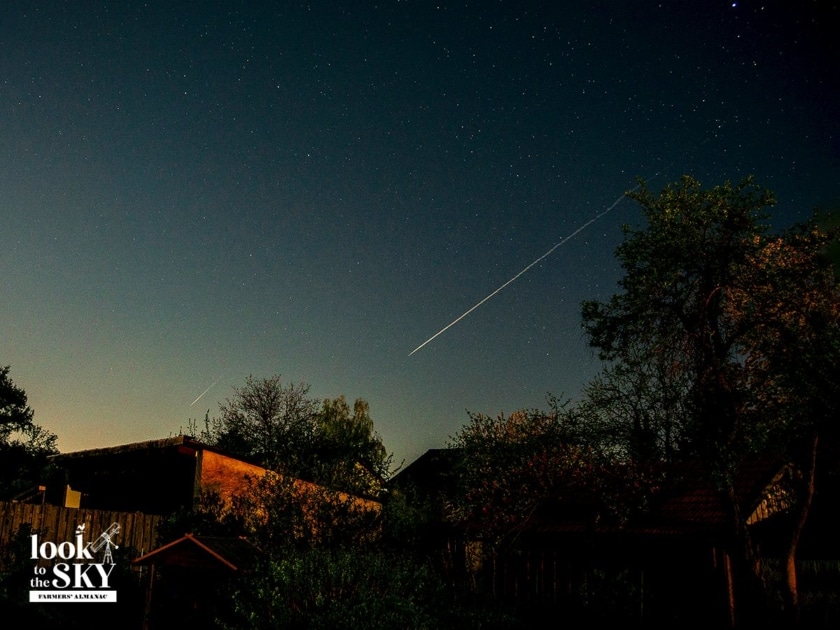April will be an exciting month to see stars and planets—especially Venus and Jupiter shining brightly together. There’s even a meteor shower toward the end of the month! Bookmark this page so you can easily refer to it over the next few weeks. And if you’re interested in locating particular planets in the sky throughout the year, be sure to consult our visible planets guide.
April 1—New Moon, 2:24 a.M.
Venus, Saturn and Mars: At about an hour and fifteen minutes before sunrise, early risers can look low, near the east-southeast horizon for a cluster of these three planets. The brightest and easiest to see will be Venus, just past its March 20th greatest elongation from the Sun. It’s less than 20° high (about two fists high above the horizon) at sunrise. (Its blaze dims a little later in April, as it recedes from Earth and its globe shrinks). The other two planets, off to Venus’ right, are much dimmer: 4° away is Saturn and another 2° to Saturn’s right is Mars. Use binoculars to see them better than your naked eye.
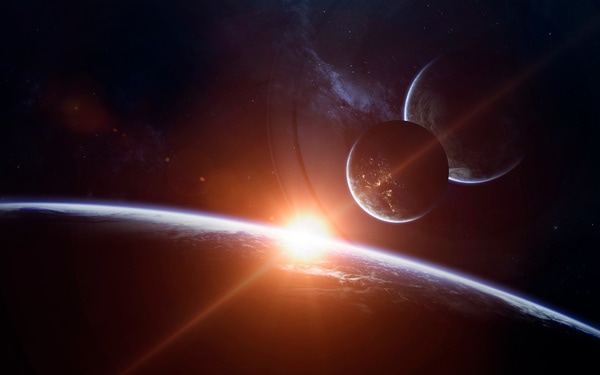
April 2—Mercury: superior conjunction
The illustration below demonstrates “super conjunction.” Mercury does not become visible until mid-April. (See: April 18.)
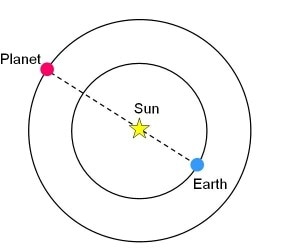
Early this morning with the two planets engaged in a rather tight conjunction. The two planets are separated by less than 0.4°, with Saturn shining above, at a magnitude of +0.9, a trifle brighter than Mars (+1.0). Binoculars will bring out Mars‘ orange-yellow color in contrast to Saturn‘s yellow-white glow.
About a half hour before sunrise, look near the eastern horizon for the bright light of Jupiter, emerging from the glare of morning twilight and situated about 20° to the lower left of Venus. Over the next three weeks, watch as Jupiter steadily climbs towards Venus and slowly and dramatically closes the gap between them by roughly one degree per day.
From our Earthly perspective, Jupiter ’s emergence from the Sun’s glare and into darker morning skies is primarily due to our motion around the Sun. As the month progresses, we move along in our orbit from where Jupiter apparently leaves the Sun behind and moves toward the west. Venus moves much more rapidly around the Sun than Jupiter. From our perspective, because Venus is closer to the Sun than we are, it appears to follow the Sun. So, this month, as Jupiter shifts away from the Sun’s vicinity, Venus has no other choice than to follow the Sun. When Jupiter first appears, on April 8, the two planets are widely separated. But with each passing morning, they draw closer to each other. They finally pass each other at month’s end.
April 9—First quarter Moon, 2:48 a.M.
Pollux (one of the bright stars of Gemini) will be 2.2° north of the Moon.
April 10-15—Castor and Pollux
Castor and Pollux, the brightest stars of Gemini (otherwise known as “The Twins”), are visible high in the west-southwest sky at dusk this week. Pollux appears to be a little over twice as bright as Castor. It’s also one of the 57 standard navigational stars. But Castor is the real “star” of Gemini. Although it appears as a single star to the naked eye, it is actually a system of six stars! In a telescope, we see two: Castor A and B. Furthermore, both A and B are themselves doubles—though much too close to be seen separately. Finally, well off to the south of the main pair is Castor C, a pair of dim red stars. To help visualize this remarkable sextuplet stellar family, picture three waltzing couples on a giant ballroom floor. Two couples (representing Castor A and B) move around each other a few feet apart, while the third pair (representing C) dances in a far corner of the room and very, very slowly circles the first two couples.
April 16—Full Pink Moon, 2:55 P.M.
No April’s Moon will not look pink, so why is it called the Full Pink Moon? Check out our video to learn more.
This month why not try one of our 16 Full Moon Rituals to help you recharge, reflect, and reconnect!
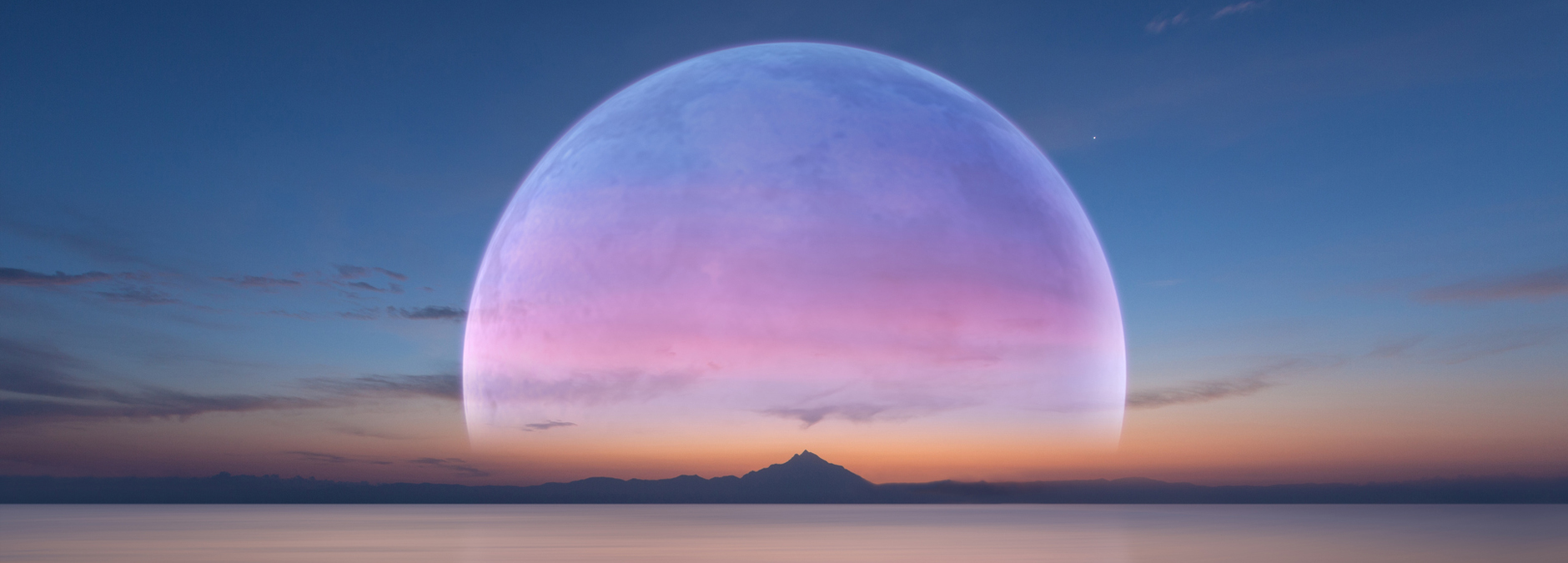
April 18—Mercury
Look 30 minutes after sunset to find Mercury shining at least 10° above the west-northwest horizon (from April 18th to May 6th). Although Mercury fades 0.1 magnitude per day, the planet will present its best evening apparition of the year during the latter half of this month.
April 22—The Lyrid meteor shower
The Lyrid meteor shower reaches its maximum this morning, when early morning observers may see 15 meteors per hour. Normally, the shower is one-quarter peak strength two days before and after maximum. So you may be able to see it April 20-24). The Moon, however, does pose some interference as it is fairly bright (nearing its last quarter phase). Especially since The Lyrids are faint meteors, with only occasional bright ones.They emanate about 6° southwest of the brilliant bluish star, Vega (in the constellation Lyra), which ascends the northeast sky in the late evening and stands practically overhead at the break of dawn. Best viewing will be after midnight.
April 23—Last quarter Moon, 7:56 a.M.
Learn more about the Phases Of The Moon.
April 25—Saturn
This morning, look for Saturn hovering like a bright yellowish-white “star” about 8° to the upper right of the fat waning crescent Moon.
April 26—the Moon will pass Mars
Early this morning the Moon will pass Mars. Both objects are visible low in the east-southeast in the early dawn, with Mars positioned about 6° to the Moon’s upper right. It brightens slightly in April, from magnitude +1.1 to +0.9, but still doesn’t appear to be more than a tiny yellow-orange dot—even in a telescope. It’s no higher in the morning sky than it was in January, February, and March. This is due to the orbital movements of Earth and Mars around the Sun.
Backstory: In January, Mars was on the far side of the Sun, as seen from Earth. If we were to consider Earth and Mars in a track race, Earth would be on the inside of the track, while slower-moving Mars is on the outside. During these last few months, Earth has been catching up to Mars, but it is still ahead, so our perspective hasn’t changed very much. In the coming months, however, as we rapidly close the gap between us, we’ll begin to notice Mars rising earlier, climbing higher, and getting noticeably brighter.
Mars is a maverick! It can go from the brightness of an ordinary-looking star to one of the brightest objects in the sky. We’re in that ordinary phase now, but wait until you see it later this year! Mark your calendars for mid-Sept, when Mars will shine brightly in the evening sky, lingering between the horns of Taurus until mid-December—its best showing for the next ten years!
April 27—Venus and Jupiter
Venus and Jupiter will dazzle above the slender crescent Moon.
April 29—Mercury and Pleiades
Mercury reaches its greatest elongation (when it appears to be furthest from the Earth), 21° east of the Sun. As twilight deepens, use binoculars to see the Pleiades star cluster about 1° to the upper right of the planet.
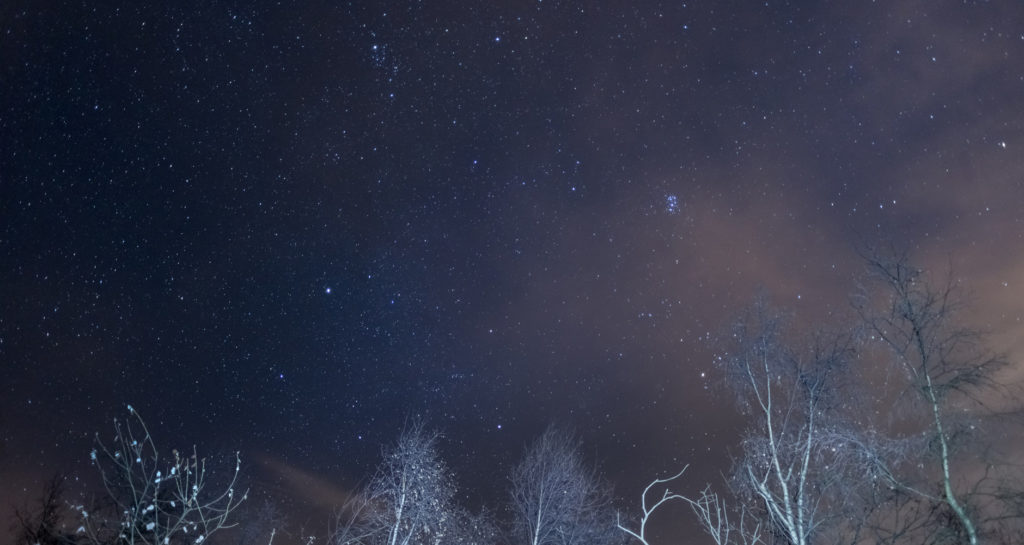
April 30—Venus conjunct Jupiter
Venus and Jupiter are in conjunction this morning. This means that they are aligned in the sky, according to our perspective on Earth. They will make a spectacular sight in the east-southeast just before sunup!
New Moon and partial solar eclipse, 4:28 p.M.
This new Moon is known as a “Black Moon,” since it is the second new Moon of the month.
This eclipse is designated as “partial” because only the penumbra, the edge of the Moon’s shadow, will be cast on the Earth. The darkest part of the shadow will in fact miss the Earth, passing approximately 750 miles below the South Pole. The penumbra, however, does graze a part of the Southern Hemisphere, resulting in a partial eclipse that will be visible in varying extent near sunset across a swath of the South Pacific Ocean, and southern and western portions of South America, including Chile, Argentina, Uruguay, southern Peru southern Bolivia, western Paraguay and a tiny slice of Brazil.
The greatest eclipse will take place over the South Pacific Ocean, 300 miles to the northwest of Yelcho, a Chilean Antarctic Research Base at South Bay, Doumer Island. A ship (trawler) near this spot will see the Sun will barely clear the west-northwest horizon, with nearly two-thirds of its diameter hidden behind the Moon. The normally thick horizon haze may redden the Sun’s light, giving it the appearance of a slice of cantaloupe. Be sure to find out when the next eclipse will happen and where you might be able to view it.
Our schedule is adapted from Skylog, a regular feature appearing in Natural History Magazine, written by Joe Rao since 1995.
Footnote: We use degrees to define the angular separation of two celestial objects, such as the Moon and a planet. It’s possible for you to estimate these distances by using your hand. For instance, your fist—held at arm’s length—approximately measures 10° of space. We also mention magnitudes, which refer to the luminescence of an object. The lower the number, the more dazzling it is. Bright stars are 1 or 0 magnitude. Fainter ones are 5 or 6. Super bright stars are in negative numbers. For instance, Sirius is -1.4. (For reference, the full Moon is -12.7 and the Sun is -26.7.)

